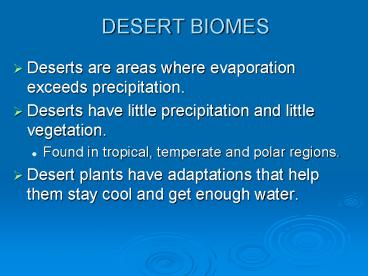DESERT BIOMES - PowerPoint PPT Presentation
1 / 18
Title:
DESERT BIOMES
Description:
Title: Chapter 5 Author: you Last modified by: wmc user Created Date: 11/8/2006 11:25:10 PM Document presentation format: On-screen Show (4:3) Company – PowerPoint PPT presentation
Number of Views:162
Avg rating:3.0/5.0
Title: DESERT BIOMES
1
DESERT BIOMES
- Deserts are areas where evaporation exceeds
precipitation. - Deserts have little precipitation and little
vegetation. - Found in tropical, temperate and polar regions.
- Desert plants have adaptations that help them
stay cool and get enough water.
2
DESERT BIOMES
- Variations in annual temperature (red) and
precipitation (blue) in tropical, temperate and
cold deserts.
Figure 5-12
3
DESERT BIOMES
- The flora and fauna in desert ecosystems adapt to
their environment through their behavior and
physiology.
Figure 5-13
4
GRASSLANDS AND CHAPARRAL BIOMES
- Variations in annual temperature (red) and
precipitation (blue).
Figure 5-14
5
GRASSLANDS AND CHAPARRAL BIOMES
- Grasslands (prairies) occur in areas too moist
for desert and too dry for forests. - Savannas are tropical grasslands with scattered
tree and herds of hoofed animals.
6
Temperate Grasslands
- The cold winters and hot dry summers have deep
and fertile soil that make them ideal for growing
crops and grazing cattle.
Figure 5-15
7
Temperate Grasslands
- Temperate tall-grass prairie ecosystem in North
America.
Figure 5-16
8
Polar Grasslands
- Polar grasslands are covered with ice and snow
except during a brief summer.
Figure 5-17
9
Chaparral
- Chaparral has a moderate climate but its dense
thickets of spiny shrubs are subject to periodic
fires.
Figure 5-18
10
FOREST BIOMES
- Variations in annual temperature (red) and
precipitation (blue) in tropical, temperate, and
polar forests.
Figure 5-19
11
FOREST BIOMES
- Forests have enough precipitation to support
stands of trees and are found in tropical,
temperate, and polar regions.
12
Tropical Rain Forest
- Tropical rain forests have heavy rainfall and a
rich diversity of species. - Found near the equator.
- Have year-round uniformity warm temperatures and
high humidity.
Figure 5-20
13
Tropical Rain Forest
- Filling such niches enables species to avoid or
minimize competition and coexist
Figure 5-21
14
Temperate Deciduous Forest
- Most of the trees survive winter by dropping
their leaves, which decay and produce a
nutrient-rich soil.
Figure 5-22
15
Evergreen Coniferous Forests
- Consist mostly of cone-bearing evergreen trees
that keep their needles year-round to help the
trees survive long and cold winters.
Figure 5-23
16
Temperate Rain Forests
- Coastal areas support huge cone-bearing evergreen
trees such as redwoods and Douglas fir in a cool
moist environment.
Figure 5-24
17
MOUNTAIN BIOMES
- High-elevation islands of biodiversity
- Often have snow-covered peaks that reflect solar
radiation and gradually release water to
lower-elevation streams and ecosystems.
Figure 5-25
18
HUMAN IMPACTS ON TERRESTRIAL BIOMES
- Human activities have damaged or disturbed more
than half of the worlds terrestrial ecosystems. - Humans have had a number of specific harmful
effects on the worlds deserts, grasslands,
forests, and mountains.































